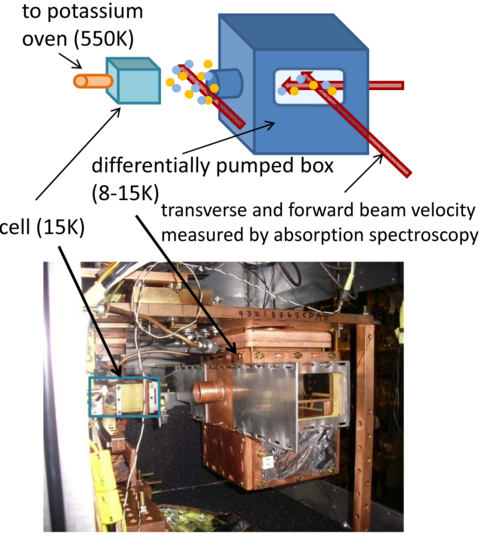Difference between revisions of "Optical Loading of Magnetic Traps"
From DoyleGroup
(→Recent Publications) |
|||
| Line 1: | Line 1: | ||
=Cold Beam = | =Cold Beam = | ||
| + | [[File:Julia_beam.png|500px|right|Picture of apparatus]] | ||
| + | |||
==People== | ==People== | ||
*David Patterson | *David Patterson | ||
| Line 5: | Line 7: | ||
==Overview== | ==Overview== | ||
| − | + | ||
We realize a continuous, high flux, cold molecular or atomic beam using buffer gas cooling techniques. Recent efforts have focused on creating such a source by mixing hot vapor (up to 600K) with cold neon buffer gas (15K) before emitting the mixture in a high flux beam. Neon buffer gas produces a beam with a forward velocity distribution and low energy tail comparable to much colder helium based beams. Such a beam may be a good starting point for laser cooling, cold collision studies, and trapping . Recent efforts have focused on magnetic trapping of potassium, but previous work realized cold beams of molecular oxygen and deuterated ammonia molecules. | We realize a continuous, high flux, cold molecular or atomic beam using buffer gas cooling techniques. Recent efforts have focused on creating such a source by mixing hot vapor (up to 600K) with cold neon buffer gas (15K) before emitting the mixture in a high flux beam. Neon buffer gas produces a beam with a forward velocity distribution and low energy tail comparable to much colder helium based beams. Such a beam may be a good starting point for laser cooling, cold collision studies, and trapping . Recent efforts have focused on magnetic trapping of potassium, but previous work realized cold beams of molecular oxygen and deuterated ammonia molecules. | ||
Revision as of 13:00, 1 December 2009
Cold Beam
People
- David Patterson
- Julia Rasmussen
Overview
We realize a continuous, high flux, cold molecular or atomic beam using buffer gas cooling techniques. Recent efforts have focused on creating such a source by mixing hot vapor (up to 600K) with cold neon buffer gas (15K) before emitting the mixture in a high flux beam. Neon buffer gas produces a beam with a forward velocity distribution and low energy tail comparable to much colder helium based beams. Such a beam may be a good starting point for laser cooling, cold collision studies, and trapping . Recent efforts have focused on magnetic trapping of potassium, but previous work realized cold beams of molecular oxygen and deuterated ammonia molecules.
Recent Publications
- Intense atomic and molecular beams via neon buffer-gas cooling, D. Patterson, J. Rasmussen, and J.M. Doyle. New Journal of Physics 11, 055018 (2009).
- Bright, Guided Molecular Beam with Hydrodynamic Enhancement, D. Patterson and J.M. Doyle. J of Chem Phys 126, 154307 (2007).
